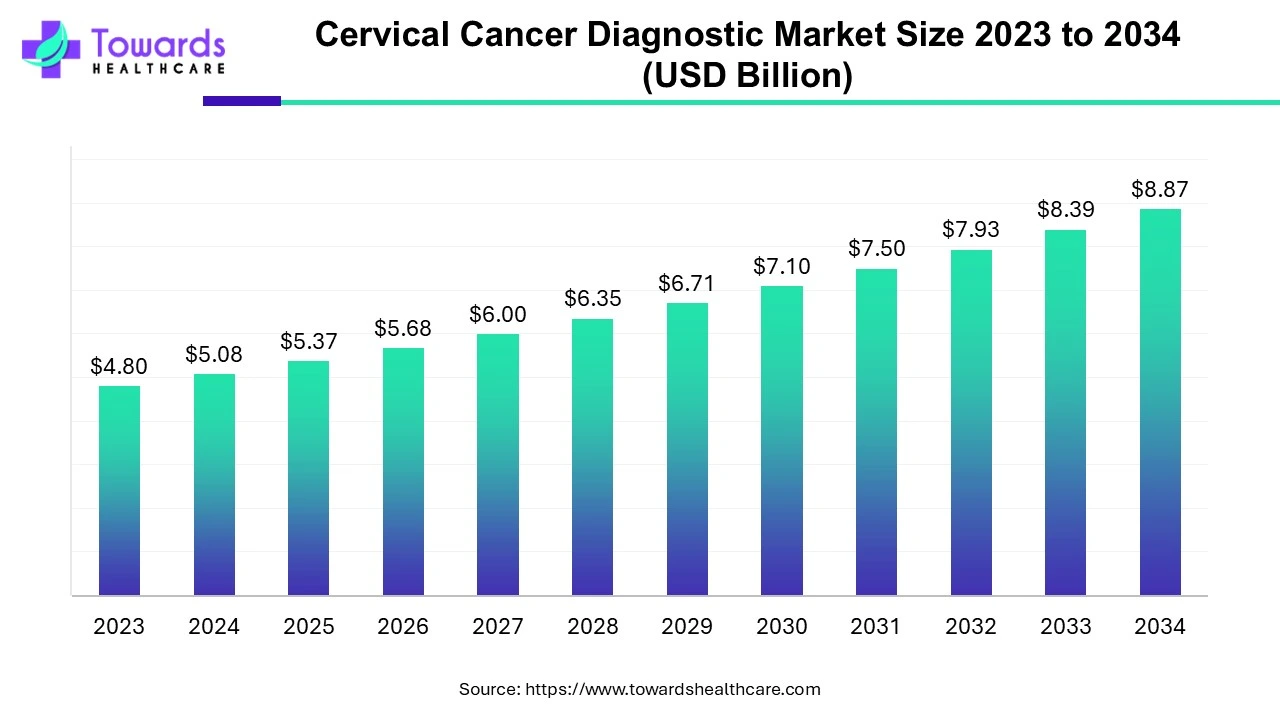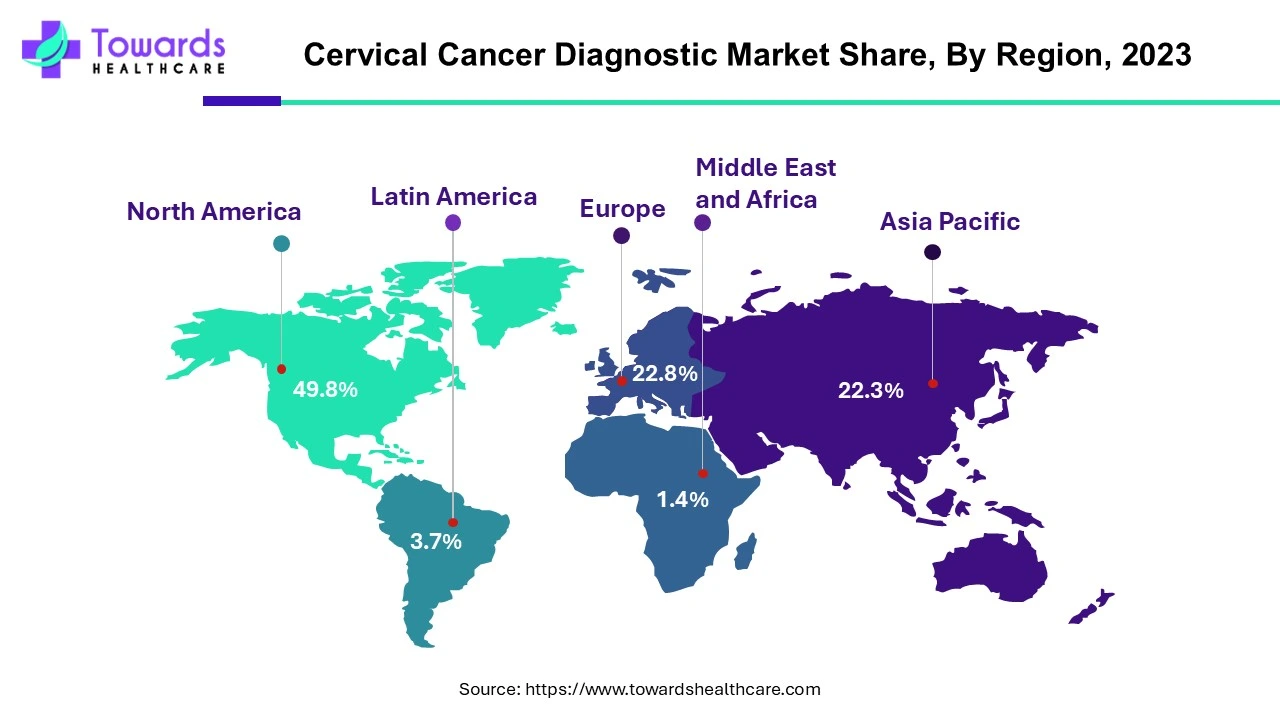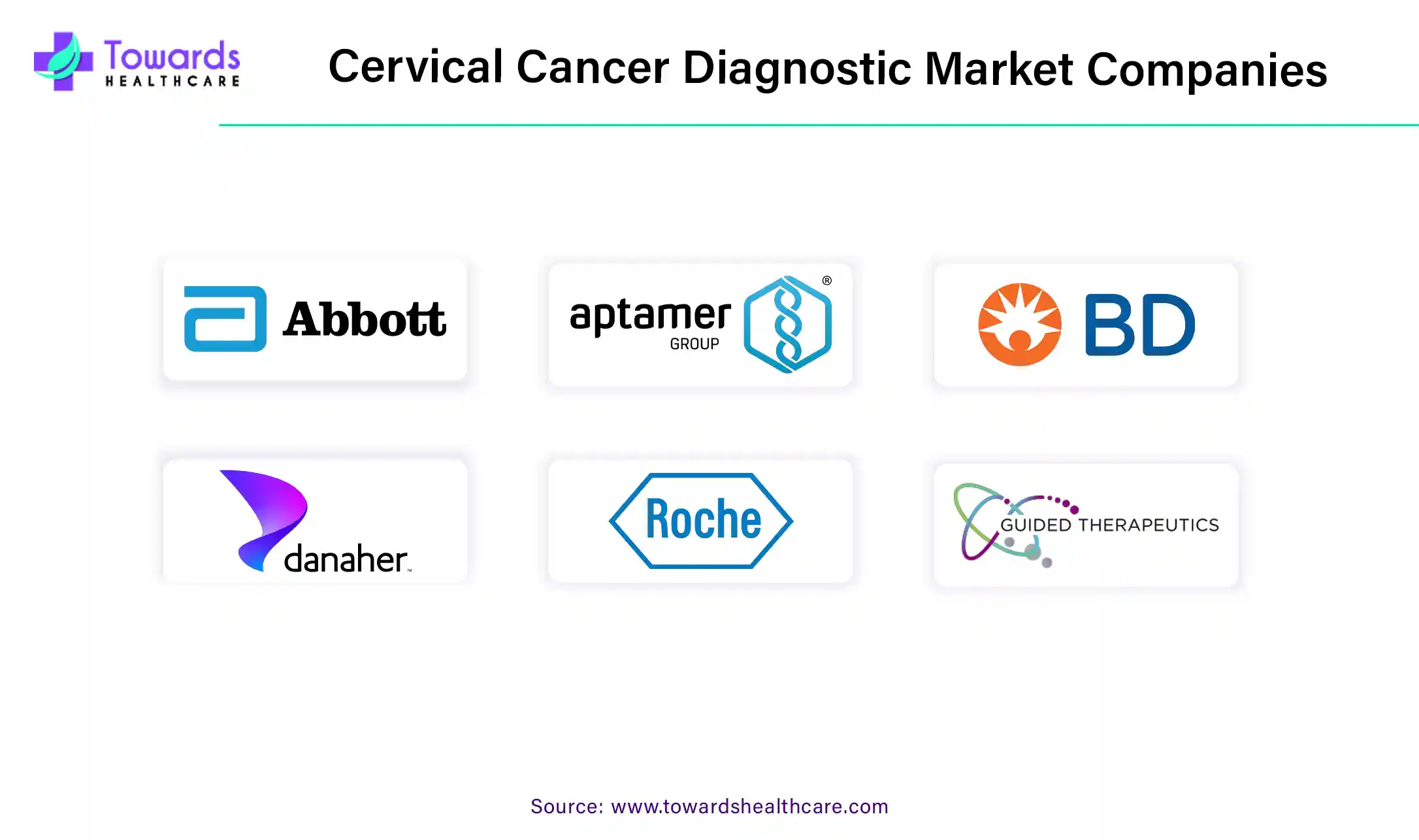December 2025

The global cervical cancer diagnostic market size is calculated at US$ 5.08 billion in 2024, grew to US$ 5.37 billion in 2025, and is projected to reach around US$ 8.87 billion by 2034. The market is expanding at a CAGR of 5.74% between 2024 and 2034. The rising incidences of cervical cancer, technological advancements, and favorable government policies drive the market.

Cervical cancer is the formation of tumors in the cervix, majorly caused by human papillomavirus (HPV) infections. Cervical cancer is diagnosed and confirmed through various stages involving numerous tests. Initially, cervical cancer cases are screened through regular Pap tests and HPV tests. These screening tests determine the risk of developing cervical cancer. If these screening tests are abnormal, more tests are done to confirm cervical cancer. These tests include colposcopy, biopsy such as punch biopsy, endocervical curettage, loop electrosurgical excision procedure (LEEP), and cone biopsy. Furthermore, after the confirmation of cervical cancer, the stage or extent of the cancer is determined. The stage is identified through imaging tests such as PET-CT scan, MRI, ultrasound, and chest X-ray. Lab tests such as complete blood count (CBC), blood chemistry study, and visual examination using cystoscopy and sigmoidoscopy are also performed to determine cancer.
The rising prevalence of cervical cancer necessitates regular screening of cervical cancer for early detection. Technological advancements favor the latest innovations in diagnostic techniques. Additionally, favorable government policies or initiatives to increase awareness about cervical cancer diagnosis boost the market.
| Countries | Incidence | Mortality |
| United States | 13,820 | 4,360 |
| Canada | 1,550 | 400 |
| China | 1,09,700 | 59,060 |
| India | 3,40,000 | - |
| Germany | 4,666 | 2,075 |
| United Kingdom | 3,791 | 1,121 |
The table below shows the incidence rates and mortality rates of cervical cancer in various countries globally in 2023. This rising trend of incidence and mortality of cervical cancer promotes early diagnosis and screening to reduce its risk at an early stage, thereby potentiating the cervical cancer diagnostic market.
Technological advancements have significantly improved the early diagnosis of cervical cancer. Integrating artificial intelligence (AI) in medical diagnostic applications can have excellent applicability in screening and diagnosing cervical cancer. Several organizations are developing AI-based methods to generate accurate results. AI and machine learning (ML) algorithms automatically recognize images, extract features, learn classification, and process data using complex algorithms. AI can reduce the time consumed for diagnosis and analysis of cervical cancer. It can also reduce the need for trained professionals to analyze test outcomes, thereby eliminating manual errors. In addition, AI can eliminate bias owing to subjective factors. AI can also aid in classifying the type and determining the stage of cervical cancer.
For instance,
Increasing Incidences of Cervical Cancer
Cervical cancer is a major concern for women as it is the fourth most common cancer type globally. According to the WHO, around 660,000 new cases were reported in 2022, with around 350,000 deaths. More than 90% of the deaths are estimated to occur in low- and middle-income countries. The major cause of cervical cancer is HPV infection, a common sexually transmitted disease. The rising prevalence of HIV can also increase the risk of causing cervical cancer. Women living with HIV are 6 times more likely to develop cervical cancer compared to the general population, and an estimated 5% of all cervical cancer cases are attributable to HIV. Hence, the increasing incidences of cases demand early diagnosis and screening, boosting the cervical cancer diagnostic market.
Lack of Awareness and High Cost
The cervical cancer diagnostic market faces formidable challenges, including a lack of awareness among women for early screening of the disease. Women, especially in developing countries, do not have sufficient knowledge about cervical cancer. Additionally, they have lack of access to information. Hence, several women are deprived of cancer diagnosis and screening. Another major challenge of the market is the relatively high cost of cervical cancer screening. The maximum average cost for initial screening, diagnostic tests, and follow-up is around $35,000 for 2 years in women younger than 21 years.
Growing Research and Development
The rising incidences of cervical cancer and favorable government initiatives to eliminate cervical cancer cases urge novel innovations for the diagnosis and treatment of the disease. The increasing investments drive research and development (R&D) in various research organizations. Some of the emerging techniques for cervical cancer prevention include liquid-based cytology, molecular testing, and AI. Therefore, the rapidly evolving genomics and proteomics research provides a breakthrough in cervical cancer diagnosis. Apart from these, point-of-care testing is also developed for the self-sampling of cervical cancer. The extended demand for point-of-care diagnostics also potentiates the cervical cancer diagnostic market. Several researchers conduct R&D to develop novel diagnostic methods to enhance the accuracy, efficiency, and cost-effectiveness of diagnostic testing.
For instance,
By test type, the Pap smear test dominated the cervical cancer diagnostic market in 2023. Pap smear test is a screening test that involves collecting cells from the cervix. During the procedure, cells from the cervix are gently scraped away and examined for abnormal growth. This test is a primary requirement for cervical cancer patients or those having a high risk of developing cancer, potentiating the segment’s growth. The low cost and the ease of performing the test without the need for complex equipment also increase the demand for Pap smear tests.
By test type, the HPV test segment is estimated to show the fastest growth in the market over the forecast period. HPV tests detect the strains of human papillomavirus that cause cervical cancer. Almost all cases of cervical cancer arise from high-risk HPV infections caused by HPV-16 and HPV-18. Hence, screening for high-risk HPV using an HPV is essential.
By age group, the 20-40 years segment held a dominant presence in the cervical cancer diagnostic market in 2023. According to several guidelines, cervical cancer screening should be started between 20-30 years in most countries globally. This age group is appropriate for identifying CIN lesions that have the potential risk of developing cervical cancer. Additionally, this age group is more vulnerable to developing cervical cancer.
By end-user, the diagnostic center segment led the global cervical cancer diagnostic market in 2023 and is projected to expand rapidly in the market in the coming years. Diagnostic centers have favorable infrastructure and availability of specialized equipment that makes them a preferable choice for cervical cancer diagnosis. The presence of skilled professionals and suitable capital investment also augment the segment’s growth. Furthermore, technological advancements and the implementation of the latest innovations drive the market.

North America held the largest share of 49.8% in the cervical cancer diagnostic market in 2023. Technological advancements, favorable government policies, the presence of key players, and advanced healthcare infrastructure drive the market. Around 14,000 people in the US receive a cervical cancer diagnosis annually. The US Government announced funding of at least $1.58 billion for the Quad Cancer Mission. The Canadian Partnership for Cancer developed an action plan to eliminate cervical cancer in Canada by 2040 with strategies including improvement of HPV vaccination, implementation of HPV primary screening, and enhanced efforts for follow-up of abnormal results. The rising incidences of cervical cancer demand early diagnosis of the disease. In the U.S., 11,500 new cases of cervical cancer are diagnosed annually.
Asia-Pacific is anticipated to grow with the highest CAGR in the cervical cancer diagnostic market during the studied years. The rising incidences of cervical cancer, favorable government support, rapidly expanding healthcare infrastructure, and growing research and development drive the market. Indonesia recently launched the National Cervical Cancer Elimination Plan (NCCEP) 2023-2030 to eliminate cervical cancer. The initiative is supported by the WHO and UNFPA. The Australian Government and philanthropic contributions extended support to the Indo-Pacific through the investment of AUD $29.6 million to the Elimination Partnership in the Indo-Pacific for Cervical Cancer (EPICC) consortium. The Indian Government committed to providing HPV sampling kits, detection tools, and cervical cancer vaccines worth $7.5 million to the Indo-Pacific region. Similarly, Japan also committed to providing medical equipment, including CT scans, MRIs, and other assistance worth $27 million to the Indo-Pacific region.

Matt Sause, CEO of Roche Diagnostics commented on the launch of its new HPV self-testing kit that the kit offers an accessible screening solution. He said that the WHO’s goal of eliminating cervical cancer can be achieved through vaccinations, innovative diagnostic tools, and screening programs. Their self-collection solution can reduce barriers and provide access to HPV screening.
By Test Type
By Age Group
By End-User
By Region
December 2025
November 2025
November 2025
October 2025